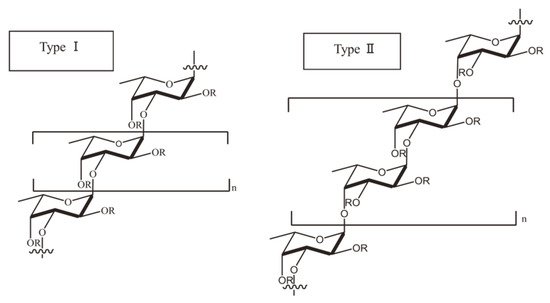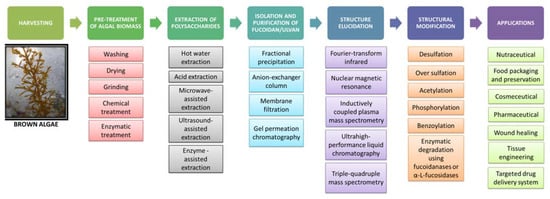You're using an outdated browser. Please upgrade to a modern browser for the best experience.
Please note this is a comparison between Version 1 by Reeta Rani Singhania and Version 3 by Jessie Wu.
The marine macroalgae produce a collection of bioactive polysaccharides, of which the sulfated heteropolysaccharide fucoidan produced by brown algae of the class Phaeophyceae has received worldwide attention because of its particular biological actions that confer nutritional and health benefits to humans and animals. The biological actions of fucoidan are determined by their structure and chemical composition, which are largely influenced by the geographical location, harvest season, extraction process, etc.
- fucoidan
- C2-
- algal biomass
1. Marine Macroalgal Sources of Fucoidan
Macroalgae, also called seaweeds, are taxonomically categorized into the phyla Chlorophyta (green algae), Rhodophyta (red algae) and Phaeophyta (brown algae). Brown seaweeds are benthic, and they inhabit the coastal ecosystems in temperate and cold-water seas [1][10]. Brown macroalgae produce the fucoidan polysaccharide [2][4] (Table 1). The brown seaweeds, such as Ecklonia cava, Ascophyllum nodosum, Cladosiphon okamuranus, Undaria pinnatifida, Saccharina longicruris, Saccharina latissima, Sargassum polycystum, Laminaria japonica, Fucus vesiculosus and Fucus serratus, are abundant sources of fucoidans [3][4][5][6][7][8][9][11,12,13,14,15,16,17].
Table 1.
Marine macroalgal sources of fucoidan polysaccharides.
| Marine Macroalga | Chemical Composition/Structure | Reference |
|---|---|---|
| Fucus evanescens | ([→3)-α-L-Fucp(2,4O SO3−)-(1→4)-α-L-Fucp(2OSO3−)-(1→])n | [10][18] |
| Sargassum horneri | repeating →3-α-l-Fucp(2 SO3−)-1→4-α-l-Fucp(2,3SO(3)(-))-1→ fragment, with insertions of →3-α-l-Fucp(2,4SO(3)(-))-1→ fragment | [11][19] |
| Laminaria longipes | [→3)-α-l-Fucp-(2SO(3)-)-(1→4)-α-l-Fucp-(1→2)-α-l-Fucp-(4 SO3−)-(1→]n | [12][20] |
| Laminaria hyperborea | (1→3)-α-L-fuco-pyranose (31.9%) to be the dominant residue, followed by 1→2-linked (13.2%) and 1→4-linked (7.7%) fuco-pyranose | [13][21] |
| Fucus evanescens | ([→3)-α-L-Fucp(2,4O SO3−)-(1→4)-α-L-Fucp(2OSO3-)-(1→]n) | [10][18] |
| Ascophyllum nodosum | [→3)-α-l-Fuc(2SO3−)-(1→4)-α-l-Fuc(2,3diSO3−)-(1]n | [6][14] |
| Fucus evanescens | [→3)-α-l-Fucp(2SO3−)-(1→4)-α-l-Fucp(2SO3−)-(1→]n | [14][22] |
| Fucus distichus | [→3)-α-l-Fucp-(2,4-di-SO3−)-(1→4)-α-l-Fucp-(2SO3−)-(1→]n | [15][23] |
2. Composition, Structure and Physicochemical Properties of Fucoidan
The fundamental subunit of fucoidan is fucose (C6H12O5) which is a deoxyhexose sugar [16][3]. The amount of L-fucose in fucoidan outweighs other monosaccharides and accounts for more than 90% of its total sugar composition [2][4]. The other monosaccharides in fucoidan comprise varying proportions of uronic acid, galactose, glucose, xylose, mannose, rhamnose, arabinose and acetyl groups [9][17][18][19][17,31,32,33]. The composition and complexity of fucoidan polysaccharides vary among different species of brown macroalgae (Table 1) and are largely influenced by geographical location and seasonal variations [19][20][33,34]. The diverse chemical compositions are reminiscent of their differences in biosynthesis. Although fucoidans do not have a universal chemical structure [2][21][4,5], the scientific literature available to date suggests principally two structural types of fucoidans: Type I fucoidan has repeating units of α-(1→3)-linked α-L-fucopyranose and Type II fucoidan has alternately repeating units of α-(1→3)- and α-(1→4)-linked α-L-fucopyranose (Figure 1) [12][17][19][22][20,31,33,35]. Several representatives of the orders Chordariales and Laminariales contain Type I fucoidan, whereas those from the order Fucales contain Type II fucoidan [6][11][14][15][23][14,19,22,23,36]. The fucose-linked sulfate groups in Type I fucoidan are found in C2- and C4-positions, whereas in Type II fucoidans they are found in C2-, C3- and C4 positions [12][22][20,35].

Different sets of fucoidans may be produced by the same species of brown seaweeds. For example, the brown seaweed Sargassum stenophyllum synthesizes two different sets of fucoidans [24][37]. One set of fucoidan contains α-L-fucose as the major component and substantial amounts of other sugars, such as β-D-galactose, β-D-mannose, α-D-glucuronic acid, α-D-glucose and β-D-xylose, with higher percentages of glucuronic acid and fewer sulfate groups located on different sugar units. The other set of fucoidan contains small amounts of α-D-glucuronic acid and high percentages of sulfate groups, which are concentrated on fucose residues, with only fucose and galactose as major components. Similarly, the brown seaweed Adenocystis utricularis also produces two different types of fucoidans; one type, called the galactofucan, is mainly composed of L-fucose, D-galactose and ester sulfate groups, whereas the other type, called the uronofucoidan, is composed mainly of fucose along with several other monosaccharides and significant amounts of uronic acids and fewer amounts of sulfate esters [25][38]. Cui et al. [26][39] extracted six different kinds of fucoidans from Saccharina japonica which varied in their monosaccharide compositions, sulfate contents and molecular weights.
The biological activities of fucoidan, such as the antioxidant and anticoagulant activities, are influenced by the variations in uronic acid and degrees of sulfation [18][27][32,40]. The degree of sulfation may vary from 15 to 30% depending on the species of brown macroalgae [22][35]. The high number of branch points in the macromolecular skeleton increases the complexity of the fucoidan structure [2][11][4,19].
Fucoidans are generally high molecular weight macromolecular structures [2][27][4,40] ranging from approximately 10 kDa [28][41] to 2000 kDa [29][42]. The method of extraction is decisive in the molecular size of fucoidan as high temperature induces breaks in the molecule, resulting in fragmentation, whereas the use of strong chemicals can introduce chemical groups into the polysaccharide structure [27][40].
The fucoidans are anionic owing to the negative charge of the macromolecular skeleton imparted by the presence of sulfate ester groups. The biological interactions of fucoidans with various macromolecular structures, such as proteins, are based on their charge density and fine chemical characteristics [2][4]. It is a highly hygroscopic polysaccharide and is soluble in water and acidic solutions [17][31]. The solubility of fucoidan is largely dependent on the level of branching and the number of sulfate groups. Though water-soluble, fucoidans do not yield highly viscous solutions and are not used as gelling agents for industrial applications. However, the addition of NaCl, CaCl2 and sugars can increase the dynamic viscoelasticity of fucoidan [30][43]. The dynamic viscoelasticity of fucoidan in an aqueous solution is determined by several factors, such as the originating species, concentration of fucoidan and its molecular weight, sulfate content, branching points, pH and temperature. The fucoidan obtained from the commercially cultured C. okamuranus showed stable dynamic viscoelasticity over a wide range of pH, whereas it decreased with an increase in temperature [30][43]. Blending with other polymers, such as chitosan [31][44] and poly(2-hydroxyethyl methacrylate) [32][45], of opposite net charge can facilitate electrostatic interaction with the negatively charged sulfate groups of fucoidan and thus improve its rheological properties and gel formation. Additionally, blending with such biocompatible polymers makes fucoidan suitable for biomedical applications.
3. Extraction, Purification and Structural Modification of Fucoidan
The sulfated heteropolysaccharides from marine seaweeds are obtained through various time- and resource-intensive sequential steps, such as harvesting, washing, mechanical, chemical or enzymatic pretreatment of algal raw material, followed by extraction of the polysaccharides using various extraction agents, isolation, purification and finally lyophilization and preservation for various intended applications (Figure 2).
Figure 2.
Processes in the extraction, purification and applications of fucoidan.
3.1. Harvesting and Pretreatment of Algal Biomass
Numerous microbes and epiphytes are found inhabiting the surface of macroalgae and they produce polysaccharides which need to be removed by surface sterilization protocol to prevent hampering of the purity of fucoidan. The harvested algae are first washed to remove salt, sand and epiphytes. The washed algae are then dried in shade, and ground into powder to increase the surface area for the action of extraction agents to be used in the subsequent steps and to enhance the release of polysaccharides. The algal biomass contains macromolecules other than fucoidan, such as other polysaccharides, proteins, lipids and pigments, which may blemish the purity of the final product. Chemical or enzymatic pretreatment steps are employed to remove these impurities. Treating the algal biomass with ethanol or acetone removes lipids and pigments [33][46]. The compounds, such as polyphenyl, chlorophyll and aroma extracts, can be removed by adsorption onto activated charcoal. Chloroform/methanol solvent mixture is also used for the removal of algal pigments [34][47]. The polysaccharides in algal biomass other than the desired fucoidan can be removed by sequential extraction and precipitation [34][47].3.2. Extraction of Fucoidan
The conventional methods of extraction of fucoidan are hot water extraction and acid extraction [35][48]. Hot water extraction is performed at 80–90 °C in solutions containing sodium oxalate or ammonium oxalate as divalent cation chelator that can chelate the Ca2+ that crosslinks the sulfated polysaccharide strands in the algal cell wall [36][49]. Acid extraction is performed using dilute HCl [25][36][38,49]. The residual algal biomass obtained by filtration or centrifugation after the initial extraction of polysaccharides is usually subjected to several extraction cycles to maximize the yield of polysaccharides. Table 2 summarizes the various extraction methodologies reported for the extraction of fucoidan polysaccharides from marine macroalgal biomass.Table 2.
Methods of extraction of fucoidan from macroalgal biomass.
| Macroalgal Species | Extraction Method | Extraction Yield/Efficiency | Reference |
|---|---|---|---|
| Ascophyllum nodosum | Microwave-assisted extraction | 16.08% | [37][50] |
| Fucus vesiculosus | Pressurized liquid extraction at high temperature | 25.99 ± 2.22% | [38][51] |
| Fucus vesiculosus | Microwave-assisted extraction | 18.2 ± 1.4% | [39][52] |
| Fucus vesiculosus | Autohydrolysis process | 16.5 ± 1.2% | [39][52] |
| Fucus vesiculosus | Microwave-assisted extraction | 18.22% | [40][53] |
| Nizamuddinia zanardinii | Ultrasound-assisted extraction | 3.51% | [41][54] |
| Sargassum myriocystum | Enzyme-assisted extraction | 6.2% | [33][46] |
| Turbinaria decurrens | Soaking in chloroform/methanol, sequential extraction in CaCl2, HCl | 5.58% (crude) 1.28% (purified) |
[34][47] |
| Sargassum ilicifolium | Probe sonication–microwave assisted extraction method Hot water extraction method |
8 ± 0.9% 6 ± 0.5% |
[42][55] |
